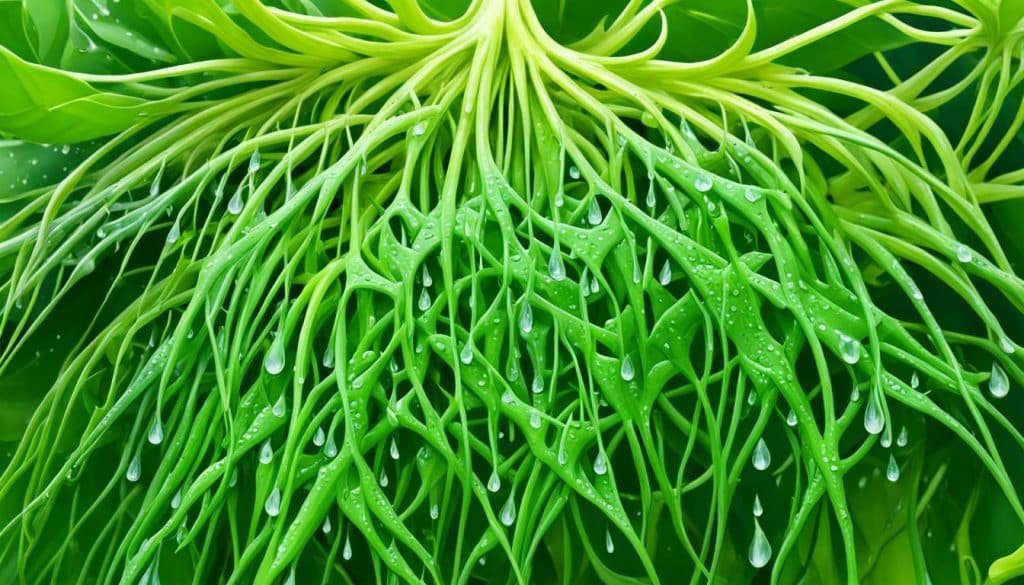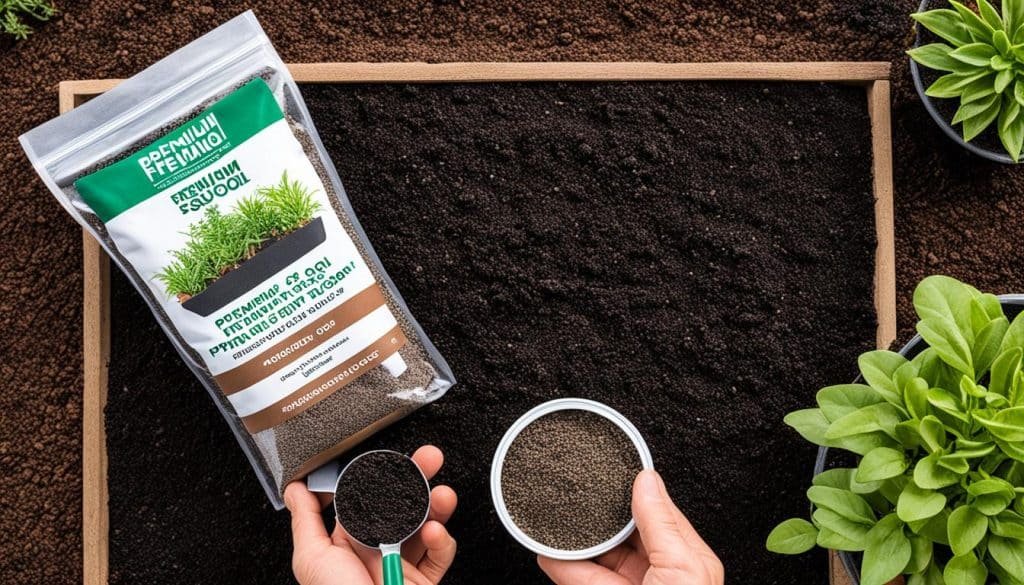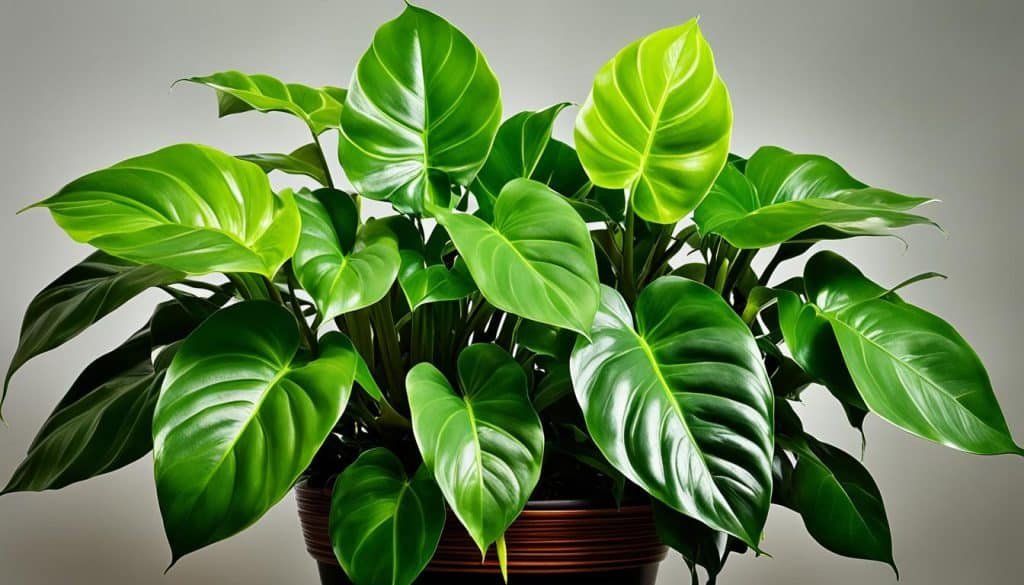Embrace the serene beauty and easy care of the philodendron green congo, a spectacular indoor plant that brings a piece of the tropics into your home. Known for its tropical foliage and lush greenery, this variety is the perfect pick for those craving an exotic yet effortless touch of nature. Thriving in low light and with its low-maintenance needs, the Philodendron Green Congo is ideal for both seasoned gardeners and newcomers looking to cultivate their very own indoor oasis.
Table of Contents
Unveiling the Philodendron Green Congo Variegated
Stepping into the realm of lush indoor greenery, the Philodendron Green Congo Variegated emerges as a magnificent variety that not only captivates with its striking appearance but also enhances the air quality of your home. This splendid variety, known scientifically as Philodendron bipinnatifidum, is a testament to the rich biodiversity of the tropics and a jewel in the crown for aficionados of tropical foliage.
Origins and Exotic Presence
Envision the dense rainforests of Central and South America, where the Philodendron Green Congo Variegated thrived amidst the towering trees and teeming plant life. Its roots in these bounteous ecosystems are a clear indication of its resilience as a hardy indoor plant, bringing a snippet of exotic beauty into urban living spaces.
Raising the Bar for Indoor Greenery
The presence of the Philodendron Green Congo Variegated in your home is not just an aesthetic choice; it is a functional one. With air purifying qualities, this plant stands out as a natural solution for a cleaner, fresher indoor environment, subtly working to enhance your living area while offering a visual treat with its lush greenery.
Defining Traits of Variegated Foliage
The essence of the plant’s charm lies in the variegated leaves, where swathes of dark green blend into mottled patches of light green, creating a mesmerizing kaleidoscope of color. Each heart-shaped, glossy leaf is a unique piece of artistry, reflecting the inherent elegance and vivid texture that make the Philodendron Green Congo Variegated a prized possession for any plant enthusiast.
Growth and Care: The Philodendron Green Congo Experience
Nurturing the vibrant Philodendron Green Congo is an artful process, encompassing a harmony of factors vital for healthy indoor plant growth and tropical foliage maintenance. This section provides vital tips to craft a lush, verdant display of this indoor greenery, offering both novices and experienced gardeners comprehensive insight into effective Philodendron Green Congo care.
- Soil Composition: Begin your plant care by creating a nurturing foundation. A well-drained soil blend, composed of equal parts peat moss, perlite, and potting soil, is essential for the Philodendron’s root health.
- Watering Practice: Balance in watering is critical; moisten the soil when the topsoil feels dry, but avoid over-saturation to prevent root rot — {a delicate balance promoting robust roots and vibrant growth}.
- Light Requirements: Suitable lighting conditions are non-negotiable for the Philodendron Green Congo. Indulge it with bright, indirect light while protecting it from the harshness of direct sunlight.
- Fertilization Schedule: Feed your philodendron with a balanced liquid fertilizer during its growing seasons — spring and summer. This sustenance fulfills its nutritional needs, ensuring a burst of green growth and color.
With these guidelines, your Philodendron Green Congo will not only survive but will also prosper, commanding the spotlight in any indoor setting. The proper adherence to this regimen of care is your recipe for cultivating a breath of tropical charm within your urban sanctum.
| Component | Function | Percentage |
|---|---|---|
| Peat Moss | Moisture retention | 33.3% |
| Perlite | Aeration | 33.3% |
| Potting Soil | Nutrient support | 33.3% |
Maintenance Highlights: Pruning is the finishing touch to enhance the Philodendron’s shape and health, removing any yellow or damaged leaves to encourage new foliage. Attention to such details promises a Philodendron that is as robust as it is resplendent.
Creating the Ideal Soil Mixture for Healthy Roots
For enthusiasts of the philodendron green congo, a crucial aspect of plant care involves concocting the ideal soil blend that caters to the specific needs of this tropical treasure. Understanding that the foundation of plant health lies beneath the surface, we must aim to foster a subterranean environment where roots can thrive. Let’s delve into the components and techniques that make up the perfect indoor plant soil for this verdant variety.
Essential Soil Components
To create a sanctuary for the Philodendron Green Congo‘s roots, a mix of specific ingredients is required. This blend should be rich in organic matter, facilitating healthy root expansion and nutrient absorption, while well-draining soil qualities are paramount to ensure excess water can escape, mitigating the risk of root ailments such as rot.
| Component | Role | Benefit to Philodendron Green Congo |
|---|---|---|
| Peat Moss | Moisture Control | Retains ambient moisture levels while preventing waterlogging |
| Perlite | Soil Aeration | Enhances drainage, allowing for better root respiration |
| Potting Soil | Nutrient Base | Supplies essential nutrients and supports microbial life |
Tips for Ensuring Proper Drainage
- Avoid compacting the soil too tightly around the plant, which can impede water flow.
- Ensure the pot has sufficient drainage holes to allow water to seep out post-watering.
- Consider mixing in a little sand or fine gravel to boost the soil’s drainage capacity.
- Mulch the top layer with bark chips or coir to maintain moisture levels without causing stagnation.
To reiterate, the elixir to nurturing the philodendron green congo to its full lushness is a well-considered soil mixture. Mindfully blending the right components and paying heed to proper drainage practices will set you on the course to unlock the verdant potential of your cherished indoor green essence, ensuring that the roots of your indoor oasis are as healthy as the foliage that adorns your space.
Balancing Watering Techniques for Vibrant Leaves
Mastering the art of watering philodendron green congo is key to maintaining the resplendent leaves that make this tropical favorite a standout in indoor plant care. The vibrant hues and robust health of the foliage hinge upon understanding and implementing the perfect tropical foliage hydration strategy. It is a delicate dance of providing sufficient moisture without drenching the roots, and allowing the plant to dry out just the right amount between waterings.
To accomplish this balance, constant vigilance and a responsive watering routine are paramount. The soil’s moisture level acts as a direct indicator; when the uppermost inch has dried, it is a sign to gently water the plant, while making sure not to flood it, as the Philodendron Green Congo’s roots are prone to rot in overly soggy conditions.
To attain the pinnacle of plant health and strong growth, one must navigate the watering process with precision and care.
- Check the soil moisture regularly to ensure it’s not overly dry or wet.
- Use lukewarm water to avoid shocking the plant’s roots with extreme temperatures.
- Water evenly around the plant to promote uniform hydration and root development.
- Consider the seasons and adjust watering frequency accordingly, reducing in cooler months.
Following these guidelines offers the best chance for your Philodendron Green Congo to showcase its lush, tropical essence with leaves that radiate health and vitality. Let these principles guide you as you strive for that idyllic balance, culminating in the verdant splendor of your indoor gardening endeavors.
Mastering Light and Temperature Requirements
Providing the optimal light and temperature conditions is crucial for the health and growth of low light plants like the Philodendron Green Congo. This section focuses on identifying the perfect amount of light and maintaining an ideal range of indoor temperatures for plants.
Identifying Perfect Light Conditions
Philodendron Green Congo, while tolerant of lower light conditions, achieves its full splendor when exposed to bright, indirect light. Shielding this plant from the direct sun prevents the stunning foliage from experiencing leaf scorch, thus maintaining its ornamental value. Finding a spot that receives dappled sunlight or diffused rays will help in simulating the native ambiance of this plant’s tropical origins, fostering vigorous growth and preserving its vibrant hues.
Maintaining Optimal Temperature Ranges
A stable indoor temperature for plants is vital, especially for tropical varieties such as the Philodendron Green Congo. The preferred temperature range is between 65 and 85 degrees Fahrenheit (18–29 degrees Celsius). Keeping it within this bracket minimizes stress on the plant, promoting thriving growth. In addition, endeavor to replicate the high humidity found in tropical environments to boost the health and appearance of your green congo, further enhancing its lush quality indoors.
- Low Light Tolerance: Ideal for spaces with limited natural lighting, the Philodendron Green Congo can still grow beautifully without direct sunlight, classifying it as one of the favorite low light plants.
- Temperature Consistency: Fluctuations in the indoor temperature for plants can lead to stress. Therefore, maintaining a consistent temperature within the optimum range is fundamental for the Philodendron Green Congo’s welfare.
Fertilization: Nourishing a Lush Philodendron Green Congo
When striving for a verdant and vigorous Philodendron Green Congo, a proper feeding regimen is as critical as water and light. Effective fertilizing indoor plants practices can significantly influence plant growth and the vitality of your tropical sanctuary. Optimal nutrition caters to more than just the basic needs; it ensures that your Philodendron Green Congo maintains robust health and displays its alluring foliage all year round.
Seasonal Fertilization Guidelines
Fulfilling the philodendron green congo nutrition needs is easy with a methodical approach to fertilization. Applying fertilizers in sync with the plant’s natural growth cycles propels it towards lushness. During the heightened growth of spring and summer, a monthly dose of balanced liquid fertilizer will replenish nutrients and energize the philodendron’s growth. However, as growth slows in fall and winter, reducing the frequency to once every two months will prevent nutrient overload, protecting the plant’s health in the dormant season.
Choosing the Right Fertilizer
Selecting the correct fertilizer is a keystone in plant nutrition strategy. A balanced liquid fertilizer rich in essential nutrients is the lifeline for a flourishing Philodendron Green Congo. Ensuring the chosen fertilizer has an appropriate ratio of nitrogen, phosphorus, and potassium is crucial. Too much of any can lead to nutrient burn, while too little might stunt the plant’s growth. The key lies in moderation, holistically supporting the philodendron without overwhelming it.
| Element | Purpose | Philodendron Green Congo Benefit |
|---|---|---|
| Nitrogen (N) | Leaf Growth | Encourages the growth of vibrant green leaves, boosting foliage density. |
| Phosphorus (P) | Root Development | Strengthens the root system, enhancing nutrient uptake and stability. |
| Potassium (K) | Overall Health | Promotes robust health, resistance to diseases, and efficient water use. |
Receiving the right nutrition, much like a well-crafted diet, enables the Philodendron Green Congo to exhibit its full splendor. With velvet leaves unfurling to reveal their variegated elegance, a nourished Philodendron stands as a testament to the caregiver’s devotion and understanding of fertilizing indoor plants for optimum plant growth.
Pruning Philodendron Green Congo for Fuller Growth
Embarking on indoor plant maintenance activities, such as pruning philodendron green congo, can seem daunting. Yet, it remains a fundamental aspect of tropical foliage care. Regular pruning not only shapes the plant to fit the aesthetic of your indoor space but also promotes a healthier growth pattern, resulting in a fuller and more vibrant display of greenery. Let’s explore the benefits and techniques of this essential care process.
Pruning your Philodendron Green Congo is not just a cosmetic practice; it is an investment in the plant’s future, encouraging stronger and more prolific growth.
- Encourages New Growth: Removing old or yellowed leaves allows the plant to redirect its energy towards producing fresh, lush foliage.
- Increases Air Flow: Trimming helps to improve air circulation within the canopy, which is vital for preventing disease.
- Controls Plant Size: Pruning lets you dictate the size and shape of your Philodendron Green Congo, making it a perfect fit for any indoor setting.
For optimal results, perform pruning during the Philodendron Green Congo’s active growth phase in spring and summer. With clean, sterilized tools, snip just above a leaf node to prompt new branches to form, creating a lusher plant. Diligence in pruning philodendron green congo will pay off with an impressive, sculpted presence that enhances your indoor oasis.
| Action | Benefit | Frequency |
|---|---|---|
| Remove Yellow Leaves | Prevents nutrient waste | As needed |
| Trim Leggy Stems | Encourages bushier growth | During active growth phase |
| Clear Dead Foliage | Improves overall health | As needed |
Through consistent and thoughtful pruning, your philodendron green congo will continue to be a centerpiece of verdant beauty, thriving in its pot and basking in the admiration it deserves.
Effortless Propagation of Your Indoor Oasis
As an indoor plant enthusiast, broadening your green collection through propagating philodendron green congo can be a fulfilling endeavor. This section sheds light on three propagation techniques that enable indoor plant propagation and variegated foliage expansion, giving you more of the tranquil beauty that Philodendron Green Congo brings into your home.
Method 1: Cultivating from Stem Cuttings
Stem cuttings are a time-honored method of propagation, not only straightforward but remarkably effective. Adapted from nature’s own way of spreading plant life, this process involves these steps:
- Identify and cut a 4-6 inch section of a healthy stem, ensuring it includes at least two nodes.
- Allow the cutting to callous for a few hours, drying the cut end to reduce the risk of rot.
- Plant the cutting in a moistened mix of peat moss and perlite, maintaining a humid and warm environment for optimal rooting.
- Wait for roots to develop, usually within several weeks, before transplanting to a more permanent environment.
Method 2: Dividing for Plant Multiplication
Division caters to the immediate multiplication of your Philodendron Green Congo. This technique is particularly efficient for mature plants that have grown dense root systems:
- Carefully remove the plant from its container, taking care to minimize root disturbance.
- Examine the root ball and identify natural sections that can be separated.
- Use clean and sharp instruments to divide the plant into two or more clumps, each with roots and foliage.
- Plant each division into its own pot with fresh, well-draining soil mix and water thoroughly.
Method 3: Air Layering Philodendron Green Congo
A somewhat more advanced approach, air layering stimulates root growth directly on the stem while still attached to the mother plant. It’s an excellent way to propagate larger sections and maintain the variegation in the foliage:
- Choose a robust stem and make an upward slit below a node.
- Surround the incision with damp sphagnum moss and encase it in plastic wrap to retain moisture.
- Monitor the moss for dryness and replenish moisture as needed, watching for root development over several weeks.
- Once a substantial root system has formed, cut the stem below the rooted section and pot it separately in the appropriate soil mix.
Each of these methods not only serves to propagate new plants but also encourages the practice of nurturing and connecting with the natural world within your living space. By learning and employing these techniques, you ensure a thriving indoor garden populated with the elegant Philodendron Green Congo.
Combatting Pests and Diseases in Philodendron Green Congo
Encountering pests and diseases is an inevitable part of the philodendron green congo care journey. Keeping these issues at bay is crucial for preserving the health and beauty of your tropical foliage. Vigilant monitoring and proactive measures are your best defense against the threats that can compromise the well-being of your indoor plant. Here, we explore strategies for protecting your tropical haven from common adversaries.
Identifying and Addressing Common Pests
Dealing with indoor plant pests is a task that requires consistent attention. The philodendron green congo, with its lush leaves, can attract unwelcome visitors such as mealybugs, spider mites, and aphids. These pests can inflict significant damage if left unchecked. Regularly examining your plant for signs of infestation, such as sticky residue or webbing, is vital for early detection and intervention. Treatments with insecticidal soap or neem oil are effective remedies for these pests, offering a layer of tropical foliage protection that keeps your philodendron healthy and thriving.
Preventing and Curbing Overwatering Illnesses
Overwatering is a treacherous pitfall that leads to diseases in philodendron green congo, especially the dreaded root rot. This condition arises when excess moisture suffocates the roots, creating an anaerobic environment ripe for pathogen infiltration. To prevent this, ensure that your watering schedule aligns with the plant’s needs, allowing the soil to dry slightly between sessions. Should signs of rot emerge—like a musty smell or discolored leaves—address the issue promptly by examining the root system and removing any decayed sections. A move to fresh, well-draining soil can give your philodendron a new lease on life, keeping this symbol of your indoor oasis in peak condition.

Gardening is my passion and growing plants indoors has always been a stress relief for me. Grow a banana tree in my apartment once (although failed to produce bananas).









